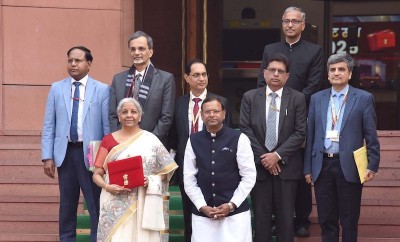
India to ramp up uranium imports nearly 4x by 2033 to fuel nuclear push
New Delhi: India has decided to significantly scale up its uranium imports to support a major expansion of nuclear power generation under its National Nuclear Energy Mission, Moneycontrol reported.
According to senior officials familiar with the matter, the country will import at least 9,000 metric tonne units (MTU) of uranium between 2025 and 2033, nearly four times the 2,600.299 MTU it imported over the last five years at a cost of ₹2,090 crore, said the report.
India currently has a natural uranium reserve of 4,25,570 tonnes, but poor ore quality has made domestic mining expensive.
Officials indicated that Russia is likely to become a key supplier in the coming years, with Australia also being explored for new sourcing agreements. India already has long-term uranium supply contracts with Uzbekistan, Canada and Kazakhstan, the report said.
In FY21 alone, 2,000.299 MTU was sourced from Canada and Kazakhstan, while Uzbekistan supplied 350 MTU in FY24 and 250 MTU in FY25. There were no imports recorded in FY22 and FY23.
The current installed nuclear power capacity in the country is 8.88 GW, and this is expected to rise to 22.48 GW by 2031-32, eventually reaching 100 GW by 2047.
To enable this transition, India has launched the National Nuclear Energy Mission with a budget of ₹20,000 crore.
The initiative includes proposed amendments to the Atomic Energy Act, 1962 and the Civil Liability for Nuclear Damage Act, 2010, aimed at opening the door for private sector participation.
However, until FY32-FY33, capacity expansion will largely be driven by public sector players such as Nuclear Power Corporation of India Ltd (NPCIL) and NTPC Ltd.
Officials said the near-term 22.48 GW target will be largely met through indigenous Pressurized Heavy Water Reactors (PHWRs), which do not require enriched uranium.
These reactors use natural uranium—mostly made up of U-238 and about 0.7% U-235—and rely on heavy water as a moderator and coolant, which enhances neutron efficiency.
At present, eight reactors with a combined capacity of 6.6 GW are under construction, while 10 more, totalling 7 GW, are in the pre-project stage.
India typically imports uranium ore concentrate, or yellowcake, which is then converted into uranium dioxide (UO₂) and fabricated into fuel bundles domestically for use in PHWRs.
With India’s energy needs rapidly growing across traditional and emerging sectors—from electric vehicles and light industry to data centres and AI infrastructure—peak power demand is projected to rise sharply.
The National Electricity Plan projects demand could soar to 458 GW by 2032, up from 250 GW recorded in FY25.
“Nuclear (energy) is a clean and dispatchable source of electricity and heat that can be deployed at scale with round-the-clock availability. It brings proven energy security benefits to electricity markets as well as reductions in emissions, complementing renewable energy,” said the International Energy Agency in its report The path to a new era for nuclear energy, released earlier this year, Moneycontrol reported.
By 2047, India aims to meet 10% of its nearly 1,000 GW total electricity generation capacity through nuclear energy.
Support Our Journalism
We cannot do without you.. your contribution supports unbiased journalism
IBNS is not driven by any ism- not wokeism, not racism, not skewed secularism, not hyper right-wing or left liberal ideals, nor by any hardline religious beliefs or hyper nationalism. We want to serve you good old objective news, as they are. We do not judge or preach. We let people decide for themselves. We only try to present factual and well-sourced news.







